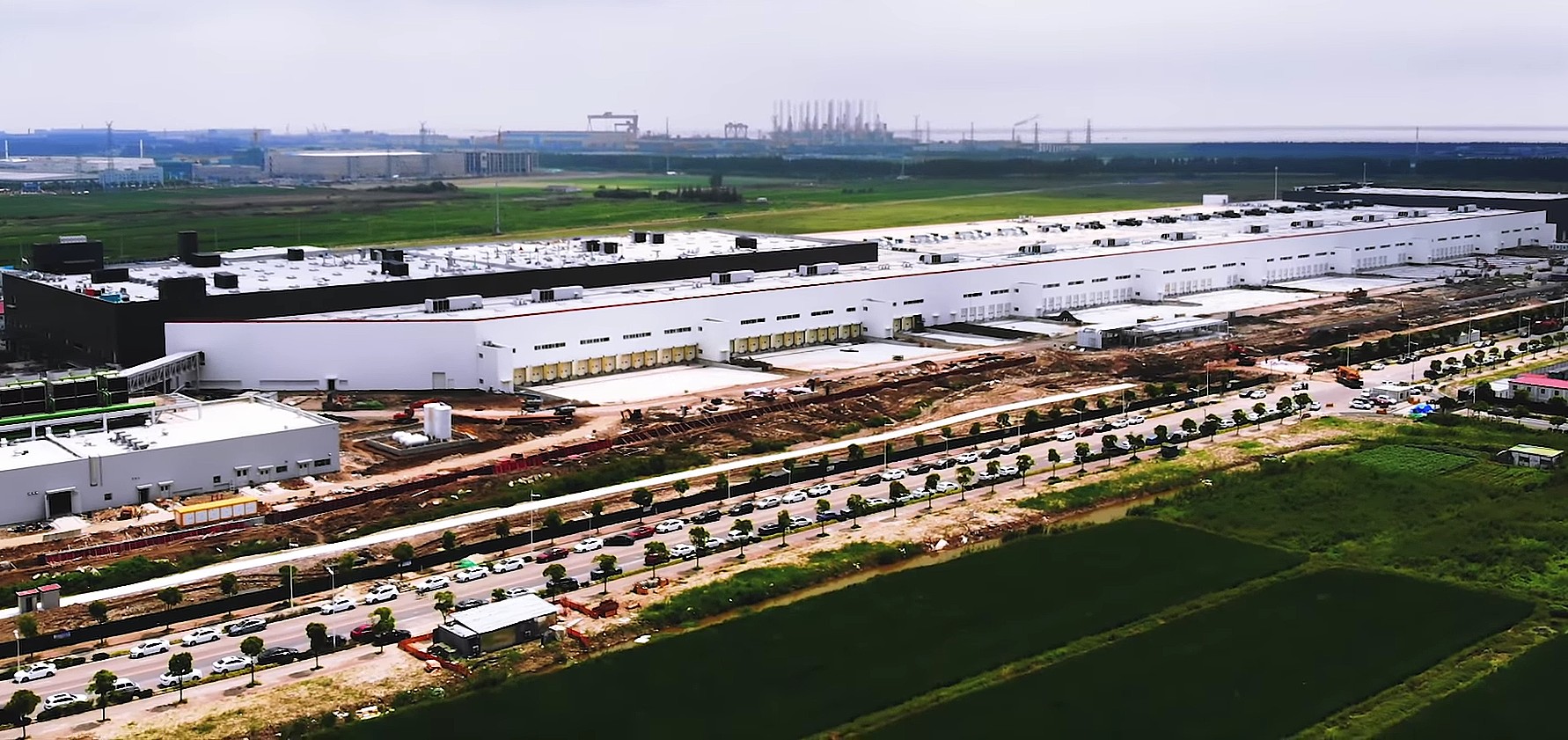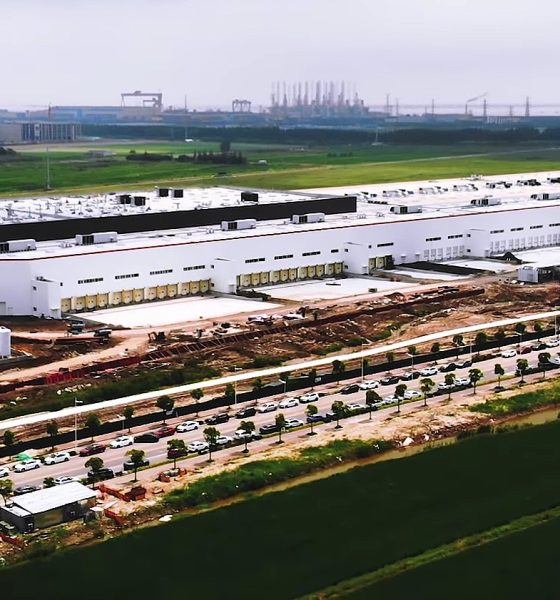

News
Tesla Gigafactory 3 complex sees preparations for next, big expansion
Recent footage of Tesla’s Gigafactory 3 complex in Shanghai suggests that the electric car maker’s construction partner is busy preparing for what appears to be the buildout of another massive facility at the south end of the general assembly building. Neither Tesla nor local reports have revealed what the upcoming facility will be, though recent tweets from CEO Elon Musk suggest that the new building could help Gigafactory 3 produce batteries and powertrains for the Model 3 and Model Y.
During a recent interaction on Twitter, Musk mentioned that Gigafactory Shanghai will produce “cars, batteries & drive units” at the same site. This is a far different strategy from Tesla’s current setup in the United States, which involves vehicle assembly being performed in the Fremont factory, and battery and drive unit production being done in Gigafactory Nevada. Tesla’s setup in China will likely prove beneficial for the electric car maker, as parts manufacturing and vehicle assembly could be accomplished in one complex.
Gigafactory 3’s Phase One construction was recently completed, with the site’s general vehicle assembly building practically ready for activation. Images and a video taken inside the massive building suggests that a Model 3 assembly line is already in place, and manufacturing robots have been set up. In the days leading up to Elon Musk’s recent visit to China alone, pictures from Gigafactory 3’s interior revealed that the electric car maker is already conducting trial runs on the Model 3 assembly line.
Yet with Phase One being complete, much of the more visible updates to the Gigafactory 3 complex lies in the southern end of the site, where several cranes and pile drivers are currently deployed. The very same machinery were deployed in the early days of the general assembly building’s construction, which suggests that preparations are now underway for another massive buildout in the Gigafactory 3 complex. The area where these activities are ongoing could be seen in a recent video from drone operator Jason Yang, who has been following the site’s development since its groundbreaking ceremony back in January.
Apart from the potential size of the new structure that will be rising from Gigafactory 3’s Phase 2 buildout, the ongoing pace of work at the site is also very impressive. Statements from several workers on the complex indicate that activities in Gigafactory 3 continue to adopt a 24/7 scheme, despite the Phase One stage being completed. This means that since the earliest days of its buildout, neither Tesla nor its Chinese construction partner have let up in their efforts to finish the facility in the fastest time possible.
When he attended Gigafactory 3’s groundbreaking ceremony, Tesla CEO Elon Musk stated that trial Model 3 production runs could start as early as the end of 2019. So far, the pace of Gigafactory 3’s construction has exceeded this, with local reports suggesting that the general assembly building could start Model 3 trial production runs as soon as the southwest substation is ready for operation. Interestingly enough, reports have suggested that the substation could go online as early as the end of September.
Watch the recent drone flyover of the Gigafactory 3 complex in the video below.

News
Tesla FSD fleet is nearing 7 billion total miles, including 2.5 billion city miles
As can be seen on Tesla’s official FSD webpage, vehicles equipped with the system have now navigated over 6.99 billion miles.

Tesla’s Full Self-Driving (Supervised) fleet is closing in on almost 7 billion total miles driven, as per data posted by the company on its official FSD webpage.
These figures hint at the massive scale of data fueling Tesla’s rapid FSD improvements, which have been quite notable as of late.
FSD mileage milestones
As can be seen on Tesla’s official FSD webpage, vehicles equipped with the system have now navigated over 6.99 billion miles. Tesla owner and avid FSD tester Whole Mars Catalog also shared a screenshot indicating that from the nearly 7 billion miles traveled by the FSD fleet, more than 2.5 billion miles were driven inside cities.
City miles are particularly valuable for complex urban scenarios like unprotected turns, pedestrian interactions, and traffic lights. This is also the difference-maker for FSD, as only complex solutions, such as Waymo’s self-driving taxis, operate similarly on inner-city streets. And even then, incidents such as the San Francisco blackouts have proven challenging for sensor-rich vehicles like Waymos.
Tesla’s data edge
Tesla has a number of advantages in the autonomous vehicle sector, one of which is the size of its fleet and the number of vehicles training FSD on real-world roads. Tesla’s nearly 7 billion FSD miles then allow the company to roll out updates that make its vehicles behave like they are being driven by experienced drivers, even if they are operating on their own.
So notable are Tesla’s improvements to FSD that NVIDIA Director of Robotics Jim Fan, after experiencing FSD v14, noted that the system is the first AI that passes what he described as a “Physical Turing Test.”
“Despite knowing exactly how robot learning works, I still find it magical watching the steering wheel turn by itself. First it feels surreal, next it becomes routine. Then, like the smartphone, taking it away actively hurts. This is how humanity gets rewired and glued to god-like technologies,” Fan wrote in a post on X.
News
Tesla starts showing how FSD will change lives in Europe
Local officials tested the system on narrow country roads and were impressed by FSD’s smooth, human-like driving, with some calling the service a game-changer for everyday life in areas that are far from urban centers.

Tesla has launched Europe’s first public shuttle service using Full Self-Driving (Supervised) in the rural Eifelkreis Bitburg-Prüm region of Germany, demonstrating how the technology can restore independence and mobility for people who struggle with limited transport options.
Local officials tested the system on narrow country roads and were impressed by FSD’s smooth, human-like driving, with some calling the service a game-changer for everyday life in areas that are far from urban centers.
Officials see real impact on rural residents
Arzfeld Mayor Johannes Kuhl and District Administrator Andreas Kruppert personally tested the Tesla shuttle service. This allowed them to see just how well FSD navigated winding lanes and rural roads confidently. Kruppert said, “Autonomous driving sounds like science fiction to many, but we simply see here that it works totally well in rural regions too.” Kuhl, for his part, also noted that FSD “feels like a very experienced driver.”
The pilot complements the area’s “Citizen Bus” program, which provides on-demand rides for elderly residents who can no longer drive themselves. Tesla Europe shared a video of a demonstration of the service, highlighting how FSD gives people their freedom back, even in places where public transport is not as prevalent.
What the Ministry for Economic Affairs and Transport says
Rhineland-Palatinate’s Minister Daniela Schmitt supported the project, praising the collaboration that made this “first of its kind in Europe” possible. As per the ministry, the rural rollout for the service shows FSD’s potential beyond major cities, and it delivers tangible benefits like grocery runs, doctor visits, and social connections for isolated residents.
“Reliable and flexible mobility is especially vital in rural areas. With the launch of a shuttle service using self-driving vehicles (FSD supervised) by Tesla in the Eifelkreis Bitburg-Prüm, an innovative pilot project is now getting underway that complements local community bus services. It is the first project of its kind in Europe.
“The result is a real gain for rural mobility: greater accessibility, more flexibility and tangible benefits for everyday life. A strong signal for innovation, cooperation and future-oriented mobility beyond urban centers,” the ministry wrote in a LinkedIn post.
News
Tesla China quietly posts Robotaxi-related job listing
Tesla China is currently seeking a Low Voltage Electrical Engineer to work on circuit board design for the company’s autonomous vehicles.

Tesla has posted a new job listing in Shanghai explicitly tied to its Robotaxi program, fueling speculation that the company is preparing to launch its dedicated autonomous ride-hailing service in China.
As noted in the listing, Tesla China is currently seeking a Low Voltage Electrical Engineer to work on circuit board design for the company’s autonomous vehicles.
Robotaxi-specific role
The listing, which was shared on social media platform X by industry watcher @tslaming, suggested that Tesla China is looking to fill the role urgently. The job listing itself specifically mentions that the person hired for the role will be working on the Low Voltage Hardware team, which would design the circuit boards that would serve as the nervous system of the Robotaxi.
Key tasks for the role, as indicated in the job listing, include collaboration with PCB layout, firmware, mechanical, program management, and validation teams, among other responsibilities. The role is based in Shanghai.
China Robotaxi launch
China represents a massive potential market for robotaxis, with its dense urban centers and supportive policies in select cities. Tesla has limited permission to roll out FSD in the country, though despite this, its vehicles have been hailed as among the best in the market when it comes to autonomous features. So far, at least, it appears that China supports Tesla’s FSD and Robotaxi rollout.
This was hinted at in November, when Tesla brought the Cybercab to the 8th China International Import Expo (CIIE) in Shanghai, marking the first time that the autonomous two-seater was brought to the Asia-Pacific region. The vehicle, despite not having a release date in China, received a significant amount of interest among the event’s attendees.








